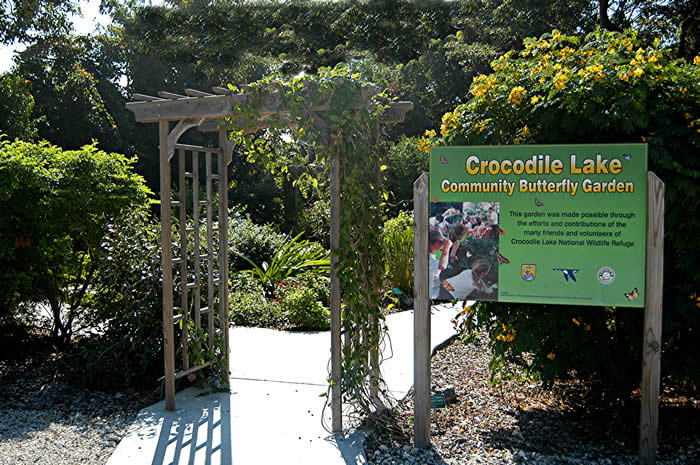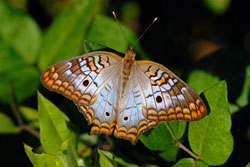Butterfly Gardening 101
The Basics | Host Plants | Nurseries | Favorite Butterfly Plants

Any habitat full of larval host plants and nectar-producing flowers is likely to be home to butterflies. When we plant our personal gardens to consciously provide food for butterflies, and we limit use of garden chemicals, we are butterfly gardeners!
Why have a butterfly garden?
- Butterflies are beautiful, and their life cycle and life styles afford hours of pleasure to observers.
- They help pollinate flowering plants.
- They provide food for other garden “wildlife” you will learn from and enjoy, such as birds.
- They are an “indicator” species, indicating environmental health by their presence or environmental trouble by their absence. If your yard is a healthy home to butterflies, it is likely to be healthy for you and your family as well.
- Butterfly gardening is something tangible you can do for conservation, whether you have a small courtyard or patio or an ample suburban lot. Like all wildlife, butterflies are threatened by loss of their natural habitats to ever-advancing human development. Many species of butterflies, however, thrive in urban and suburban settings that provide food plants for caterpillars, nectar sources for adults, and relief from chemical toxins.
How do you plant a butterfly garden?
- Assess your space and identify areas that you can set aside for garden plots.
- Don’t despair if your yard has limited sunlight. Most butterflies like sunny areas, but some prefer dappled sunlight or even shady areas. Jaret Daniels (author of Your Florida Guide to Butterfly Gardening: A Guide for the Deep South, 2000) points out that the same passion vine, planted in the sun, will attract Gulf Fritillaries; planted in the shade, Zebra Heliconians claim it.
- In addition to the sunlight patterns of your yard, know your soil and drainage conditions and plant accordingly.
- Don’t despair if you have limited space. Small butterfly gardens can be successful.
- If you have a balcony, try growing parsley, dill and fennel – see if the Black Swallowtail will find it and lay eggs.
- If you have a small courtyard, try to train some passion vines (Passiflora species) to a fence or trellis (native species are recommended, as the Zebra Heliconians, Julias, and Gulf Fritillaries seem to use them more readily than they accept most exotic passion vines).
- Try pipevine (Aristolochea species) to attract polydamus.
- Try Blue Plumbago (Plumbago auiculata) for Cassiuis Blues.
- To draw in nectaring adults, plant a clump of Ruby Red Pentas (Pentas lanceolata).
- For stable and diverse butterfly populations, strive for a diverse range of both larval host plants and flowering nectar sources for adults. Caterpillar food needs are usually quite specific and well documented in butterfly field guides and butterfly gardening books. However, adults also select flowers that accommodate the length of their proboscis and their color preferences.
- If you wish to have butterflies, but not the “chewed up” look of larval host plants, then in visible areas of your garden, emphasize nectar plants and tuck your larval host plants in less obvious areas.
- Not all adults feed only on flower nectar; some are attracted to overripe fruit and sap. Try a shallow bird bath to offer chunks of very ripe, even rotten, fruit. Jaret Daniels suggests a moat for controlling ants: place one shallow dish with the fruit in the middle of a larger shallow receptacle filled with water. The butterflies will be able to reach the fruit, but the ants will be thwarted.
- Some butterflies will “mud puddle” in damp earth where they can extract salts and other minerals. See if you have a moist low spot in your yard that might attract mud puddlers if plant material were scraped away. Or, as Daniels suggests, create a mud puddle by embedding in the ground a shallow pan filled with wet sand and a little table salt.
- Plant high and low. Some butterflies fly high in the trees, others low in shrubs and grasses. Consider larval host and nectar-providing trees and shrubs that will reach varying heights. For example, your tree canopies can attract Horace’s Duskywing with oaks, Ruddy Daggerwing with our native Strangler Fig (Ficus aurea) and Short-Leafed Fig (Ficus citrifolia), and Hammock Skipper with the Jamaican Dogwood (Piscidia piscipula). But your lawn and low shrubs will draw Grass Skippers and small Sulphurs.
- “Think thickets” when you plant. Groupings of plants provide more protection from predators and inclement weather, as well as ease of access to food, than an isolated bush or tree. Their color and texture are also pleasing to our eyes.
- Shun garden chemicals as much as possible, and then selectively “spot use” the least toxic: Pesticides, fungicides, herbicides are indiscriminate in their toxic effects. What kills a white fly or a weed won’t be healthy for a butterfly egg or caterpillar, either (and is probably not salubrious for the person who mixes and applies it).
- Go native! Experienced butterfly gardeners find that native larval host and nectar plants often are more resistant than exotics to pests and diseases, as well as more attractive to local butterflies. Moreover, native plants usually grow more effortlessly in local conditions, requiring less costly watering, fertilizers, and pesticides.
- Trim frequently to promote new leaf growth, favored by caterpillars, and new blossoms for adults to nectar.
- Don’t dismiss weeds! Many plants we have judged to be weeds are important butterfly larval host and nectar plants. In our area, Spanish Needle (Bidens alba) is the most obvious example! This member of the Aster family thrives in mowed lawns and almost any disturbed, sunny area. If it arrives in your yard, consider giving it a home, for it is larval host to the Dainty Sulphur and a nectar source to countless other butterflies.
 Look at your lawn with new eyes. Your lawn will support diverse butterflies in proportion to its diversity of grasses and small herbaceous weeds. Think of your lawn in terms of biodiversity as opposed to monoculture, and persuade yourself that a newly mown lawn full of diverse grasses and “lawn weeds” is both attractive and beneficial to butterflies. St. Augustine and Bermuda Grasses are larval hosts for several Skippers and many “lawn weeds” are, as well, butterfly plants.
Look at your lawn with new eyes. Your lawn will support diverse butterflies in proportion to its diversity of grasses and small herbaceous weeds. Think of your lawn in terms of biodiversity as opposed to monoculture, and persuade yourself that a newly mown lawn full of diverse grasses and “lawn weeds” is both attractive and beneficial to butterflies. St. Augustine and Bermuda Grasses are larval hosts for several Skippers and many “lawn weeds” are, as well, butterfly plants.
- The beautiful White Peacock seeks Creeping Charlie (Pnyla nodiflora) and Green Shrimp Plant (Blechum pyramidatum);
- The smartly marked Tropical Checkered-Skipper seeks Wireweed (Sida acuta);
- The tiny Ceraunus Blue seeks Trailing Indigo (Indigofera spicata);
- Big, athletic Dorantes and Long-tailed Skippers seek Beggar’s Tick (Desmodium incanum) and Beggarweed (Desmodium toruosum);
- Mexican Clover (Richardia grandiflora) provides nectar to a variety of butterflies.
- Obtain plant lists and butterfly gardening ideas from your local chapter of the North American Butterfly Association (www.NABA.org/chapters.html), your local native plant society, your local agricultural extension agency, local botanic gardens, or local nature centers.
- Check bookstores with good natural history selections for butterfly gardening books that specifically apply to your area. Several good gardening books are listed on this web site; click “Book List.”
- Some landscape designers specialize in butterfly gardens; be sure to ask to see examples of their established gardens, visit when you can expect to see butterflies in action and obtain references before engaging a professional.
- Once your garden is planted, be patient. It will take a little time for butterflies to discover you … and a little more time for your yard list to grow from a few species to many. You will also learn what plants and butterflies are most successful in your yard.
